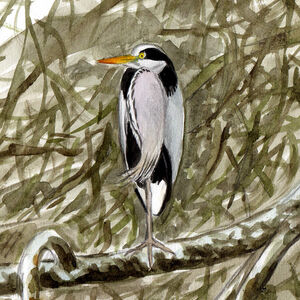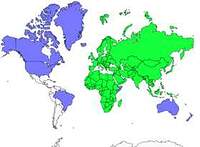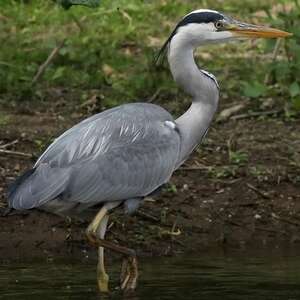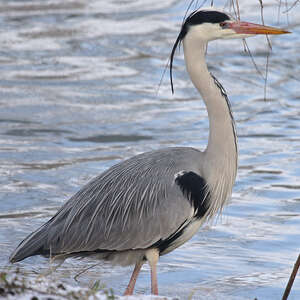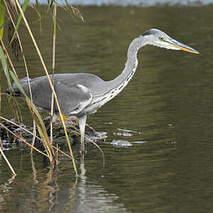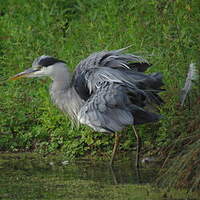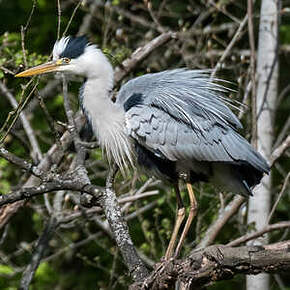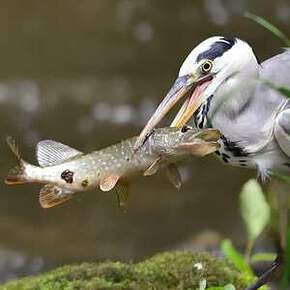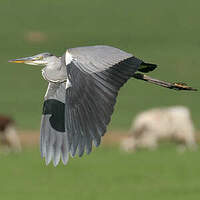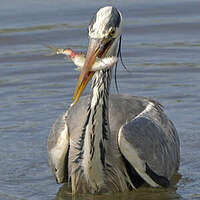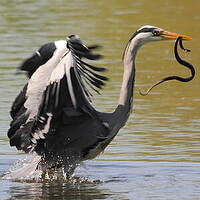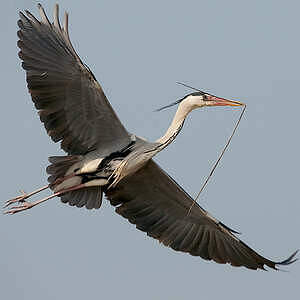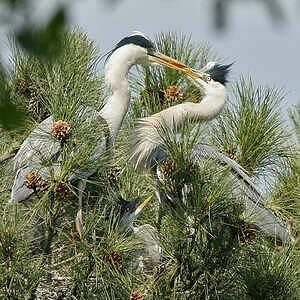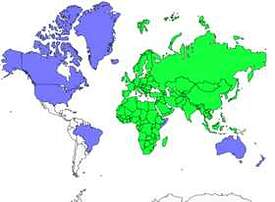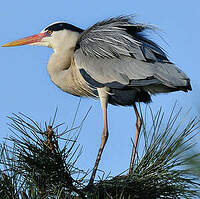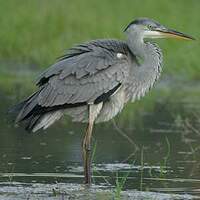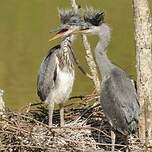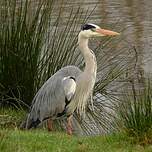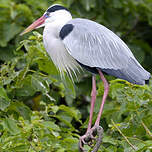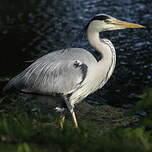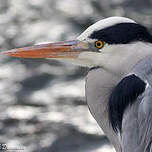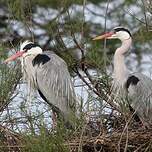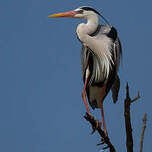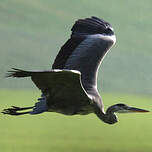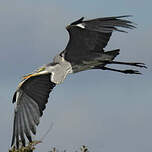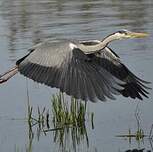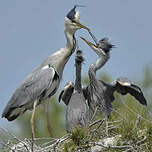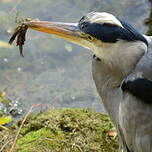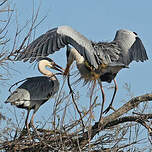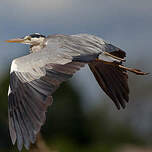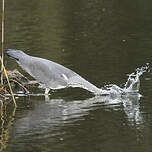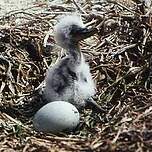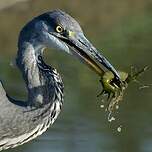Grey Heron
Ardea cinerea - Héron cendré
Identification
The Grey Heron is one of our largest members of the heron family and the largest in Europe. It is easily recogniseable by its large size, grey colouring and distinctive silhouette when flying. Its plumage is medium grey on the upperparts and white underneath. Flight feathers, remiges and rectrices are dark-brown resulting in a typical contrast between them and the rest of the body, which is easily seen during flight. The plumage becomes more pronounced in the adult. The crown feathers are well defined and extend in to a small crest. The beak yellow, the front of the neck has clear black streaks and a white patch on the wrist above the small black coverts. The scapulars lengthen and the legs lighten. This plumage is maintained for much of the year, but in the mating season the plumage of the breeding adult changes. The beak becomes a yellow orange, lores become blue, crest becomes longer, long ornament feathers grow at the bottom of the neck and around the scapulars and the legs turn even more yellow. The male can be distinguished from the female by his brighter colours. These decorations are important during mating displays. The juvenille and immature have a plumage similar to the inter-mating adult, but duller, with the upper beak and legs being dark.
Subspecific information 4 subspecies
- Ardea cinerea cinerea (w Europe to e Asia to India and Africa)
- Ardea cinerea jouyi (n China, Korea and Japan to Sumatra and Java)
- Ardea cinerea monicae (Banc d'Arguin. Mauritania.)
- Ardea cinerea firasa (Madagascar, Comoros and Aldabra)
Foreign names
- Héron cendré,
- Garza real,
- garça-real-comum,
- Graureiher,
- szürke gém,
- Blauwe Reiger,
- Airone cenerino,
- gråhäger,
- Gråhegre,
- volavka popolavá,
- volavka popelavá,
- Fiskehejre,
- harmaahaikara,
- Bloureier,
- bernat pescaire,
- Gráhegri,
- czapla siwa,
- zivju gārnis,
- siva čaplja,
- Серая цапля,
- Cangak abu,
- アオサギ,
- 苍鹭,
- นกกระสานวล,
- 蒼鷺,
Voice song and call
The Grey Heron has no song. Its usual call, for example when it takes flight, is a rough and hoarse waarr. The flight call is of the same type, but a bit softer. It's a croaking and sonorous weeh with a higher pitch. When settling in the colony, various guttural and hoarse cries can be heard. The almost grown youngbirds beg for food at the nest with repetitive kakakakakaka... peeping.
Habitat
The Grey Heron frequents all fresh or brackish waters as long as there are fishes. During the interseason, it also visits agricultural areas in search of rodents and other prey on land. To reproduce, it looks for woody areas with large trees to make its nest (forests, riparian vegetation, poplar groves, bushes and parks). Locally, reed-beds are the chosen place for nesting.
Behaviour character trait
The Grey Heron is fundamentally a gregarious bird at all times. During the breeding season, adults reproduce in colonies that can count several hundreds of nests. Territoriality is then limited to the immediate area around the nest. Outside the breeding season for adults and at all times for immatures, birds gather for the night in dormitories in places that protect them from predators (in trees, on water islets, on mudflats, etc.). On the other hand, when they are fishing, they become very solitary and territorial and fiercely defend their fishing areas against intruders.
Pursuits are then frequent. Depending on the latitude, the birds are sedentary or migratory. Siberian birds for example are migratory while French herons are at most erratic. Migratory movements are made in groups and during the day. These groups are less systematically arranged in 'V' formation than cranes, geese or cormorants. Grey Herons are naturally shy and keep their distance from humans. However, this does not prevent them from being opportunistic and, for example, coming early in the morning or late in the evening to empty a pond of its goldfish in urban areas. The species is monogamous for reproduction, but it seems that the links of the couple last only as long as the nesting. There is no loyalty over time to the partner as can be observed in other groups, like raptors for example. One might think that these large birds are hindered by their large wings and long legs when they move through trees, but this does not seem to be the case. Their wings serve to keep their balance and their long fingers to grasp even the thinnest branches.Flight
Like other herons, the Grey Heron tucks its neck in flight in order to balance the body's weight. The neck then forms a prominent loop beneath. The feet are then stretched back. Finally, the long and wide wings appear arched, with the wrist raised and the tip drooping. These characteristics are at the root of an unmistakable silhouette. Flight is ample, heavy and powerful. Herons are capable of flying great distances and many populations are migratory.
Dietfeeding habits
The Grey Heron primarily feeds on fish, particularly for the food supply of young herons. Its diet also includes amphibians such as frogs, some invertebrates such as crayfish and amphibious creatures such as the grass snake, and the water shrew, albeit marginally.
In the interseason, it is often seen in a terrestrial environment, particularly in meadows, where it hunts for fieldmice and probably also earthworms. It fishes from a motionless position, its eyes fixed on the surface. Once the fish is located, it rapidly thrusts out its neck and captures or spear its prey with its dagger-like beak if it is large enough. It undertakes the same approach for its terrestrial prey, affûting them near tunnels or seizing them by surprise while patrolling. The larger terrestrial prey is killed with its beak before being swallowed.Reproduction nesting
The Grey Heron is a monogamous colonial species. It is either arboreal or paludicole for reproduction. In the first case, the nest is built in a large tree, usually at the end of a branch in the canopy. The nest is made of twigs and branches with a roughly cut and lined with some finer plant materials. It is quite wide and flat, although relatively small for the bird's size. When such nests neighbor with Carrion Crow nests as is fairly common, the size difference may not be that obvious. It's the morphology that matters. When they neighbor with nests of other ardeids, waders or cormorants since colonies are often mixed, it may be quite hard to tell them apart and count them.
In the second case, the nest, also made of twigs but also of dry reeds as well as other marshy items, is placed on a base of crossed dry phragmites stems above the water. Another support such as a Carex tussock may also be used. Despite their rather frail structure, the nests may be used for several years, especially the arboreal ones, and they then gain in volume. The same tree may support multiple nests, up to 10 or more. The female lays three to five smooth light blue-green eggs. Incubation is alternately performed by the two parents and it lasts for about 26 days. At birth, the chicks have a somewhat comical look with their white down standing on their heads. They constantly beg for food with their incessant chirping throughout the day. They are fed by their parents who, solicited by their pecking, regurgitate some food. The chicks first take their food from the adults' beaks and later directly in the nest. Juveniles stay in the nest for about 2 months, not flying very well before the age of 55 days.Geographic range
The Grey Heron is widespread throughout the Old World, from the Atlantic to the Pacific and latitudinally, from the north of Scandinavia and Siberia to the south of Africa, India and Indonesia. It is absent from the Arctic regions, large desert areas (Sahara, Arabia, Asian deserts) and Oceania (Australia, Papua New Guinea, etc.).
Threats - protection
IUCN conservation status
concern
in the Wild
threatened
evaluated
Currently, the Grey Heron species is doing well, at least in Europe, thanks to its complete protection. It is expanding on the edges of its area. However, taking into account its colonies in managing forest areas is desirable.
Sources of information
- IOC World Bird List (v14.2), Gill, F and D Donsker (Eds). 2024-04-18.
- Grands échassiers, gallinacés, râles d'Europe, P. Géroudet
- HBW Alive,
- xeno-canto, Sharing bird sounds from around the world,
Other sources of interest
 Specification sheet created on
09/07/2023 by Jean François
Specification sheet created on
09/07/2023 by Jean FrançoisTranslation by AI Oiseaux.net
© 1996-2025 Oiseaux.net
- Accipitriformes
- Aegotheliformes
- Anseriformes
- Apodiformes
- Apterygiformes
- Bucerotiformes
- Caprimulgiformes
- Cariamiformes
- Casuariiformes
- Charadriiformes
- Ciconiiformes
- Coliiformes
- Columbiformes
- Coraciiformes
- Cuculiformes
- Eurypygiformes
- Falconiformes
- Galliformes
- Gaviiformes
- Gruiformes
- Leptosomiformes
- Mesitornithiformes
- Musophagiformes
- Nyctibiiformes
- Opisthocomiformes
- Otidiformes
- Passeriformes
- Pelecaniformes
- Phaethontiformes
- Phoenicopteriformes
- Piciformes
- Podargiformes
- Podicipediformes
- Procellariiformes
- Psittaciformes
- Pterocliformes
- Rheiformes
- Sphenisciformes
- Steatornithiformes
- Strigiformes
- Struthioniformes
- Suliformes
- Tinamiformes
- Trogoniformes

